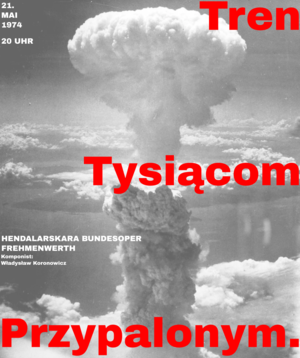Threnody to the Thousands Burned: Difference between revisions
mNo edit summary |
mNo edit summary |
||
| Line 1: | Line 1: | ||
{{AbandonLore}} | |||
[[Category:IXWB]] | |||
[[Category:Hendalarsk]] | |||
'''Threnody to the Thousands Burned''' (original [[Lechian language|Lechian]]: ''Tren Tysiącom Przypalonym'') is a composition for 41 string instruments and 121 voices created by the [[Hendalarsk|Hendalarskara]] [[Lechian]] composer [[Władysław Koronowicz]] and first performed in 1974, with the intention of commemmorating those killed in the Bombing of [Burg city], the first ever use of nuclear weaponry in combat. Widely considered its creator's masterwork, it has been performed in a range of countries worldwide, although the formidable size of its prescribed orchestra and choir can make it a major challenge to perform.[[File:Trenpost.png|thumb|The poster announcing the work's inaugural public performance in [[Frehmenwerth]].]] | '''Threnody to the Thousands Burned''' (original [[Lechian language|Lechian]]: ''Tren Tysiącom Przypalonym'') is a composition for 41 string instruments and 121 voices created by the [[Hendalarsk|Hendalarskara]] [[Lechian]] composer [[Władysław Koronowicz]] and first performed in 1974, with the intention of commemmorating those killed in the Bombing of [Burg city], the first ever use of nuclear weaponry in combat. Widely considered its creator's masterwork, it has been performed in a range of countries worldwide, although the formidable size of its prescribed orchestra and choir can make it a major challenge to perform.[[File:Trenpost.png|thumb|The poster announcing the work's inaugural public performance in [[Frehmenwerth]].]] | ||
| Line 13: | Line 16: | ||
==Notes== | ==Notes== | ||
{{reflist}} | {{reflist}} | ||
Revision as of 16:23, 13 January 2024
This article is considered abandoned lore either because its creator has changed projects or has left the community. Accordingly, it is not only non-canon but it is also eligible for salvage pending approval from an administrator.
|
Threnody to the Thousands Burned (original Lechian: Tren Tysiącom Przypalonym) is a composition for 41 string instruments and 121 voices created by the Hendalarskara Lechian composer Władysław Koronowicz and first performed in 1974, with the intention of commemmorating those killed in the Bombing of [Burg city], the first ever use of nuclear weaponry in combat. Widely considered its creator's masterwork, it has been performed in a range of countries worldwide, although the formidable size of its prescribed orchestra and choir can make it a major challenge to perform.

Description
The work is exactly 13 minutes and 13 seconds long, in keeping with Koronowicz's vision of the work as a "monument to our greatest misfortune. Thousands experienced hell, billions of us live amidst the aftermath." The work is a deeply sonoryzt one, with an uncompromising investigation of the limits of timbre at its core, although the choir also lends the often discordant work a strong harmonic undercurrent that is typically absent from 'purer' sonoryzt works. The piece's instrumental and choral units are both divided into equal groups of four - ten violas, ten violins, ten cellos and ten double basses are mirrored by thirty sopranos, thirty altos, thirty tenors and thirty basses - with one string player and one choralist as odd-ones-out. Rather than functioning as soloists in the traditional sense, the role of these two musicians is to inject dissonance into the piece at moments when the score allows for it, in the manner of jazz improvisation; consequently no two recordings or performances of the piece are ever exactly alike.
Reception and Usage
Initial reviews of the piece were mixed. Many critics were struck by the piece's harshness, with Madelena Jurisova of the Frehmenwerther Allgemeine considering it a "tour de force...a troubling and searing, but never disrespectful, examination of one of the darkest moments of our shared human experience." Others were not so generous, with the same paper's senior critic Jürgen Markemas describing it as "appalling. A depraved car-crash, 162 souls united in a common mission to desecrate the sacred memory of a tragedy. I sincerely hope it is never performed again in my lifetime."[1] Subsequent critical opinion has come to a broad consensus that the piece is a masterwork; in a 2009 domestic poll of "Gothica's greatest orchestral music", it ranked 19th overall, while the prestigious music magazine Heugabel granted the remastered 2001 performance a rare Perfekt 10 in a 2013 restrospective.
Despite (or perhaps because of) its deeply uncomfortable and uncompromising character, the work has seen use in a variety of films and other media. Avant-garde director Iarovo Kustenets has used elements of the piece as a prominent auditory motif in many of his films, including Death is a Blessing (1994) and the hugely controversial Schande (2011).
Koronowicz has never commented on others' use of his work in public, with the use of the music in an artist's subsequent work generally taken as the only firm evidence that he approves of that artist's prior engagement with the piece. Andrea Schüchtler's 1988 novel Three Hundred Comfortable Days uses the work's discordance as a prolonged metaphor for the collapse of its protagonist's sanity, culminating in a renowned sequence in which she consumes narcotics and hallucinates herself present both at the atomic bombing and in a choir performing the work.
Notes
- ↑ Markemas' wish was inadvertently granted; he died of a heart attack two years later, while the work was not performed live again until 1977.